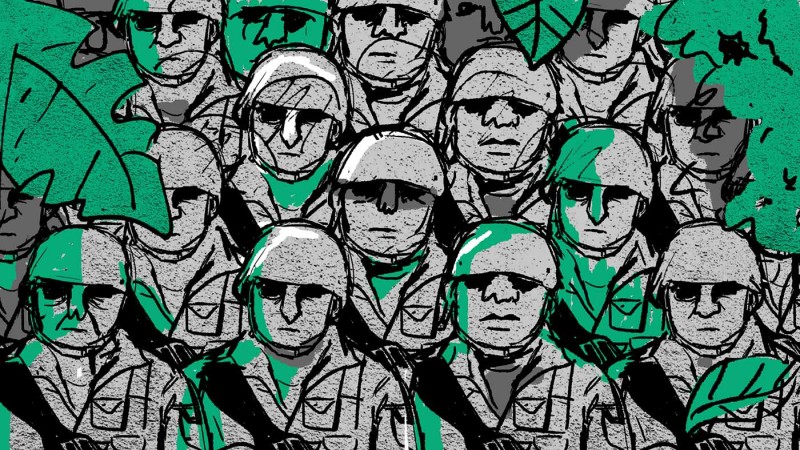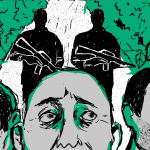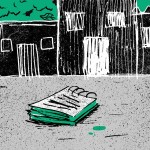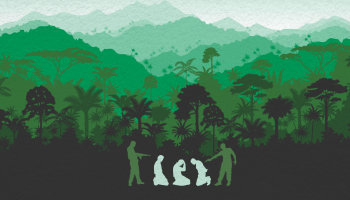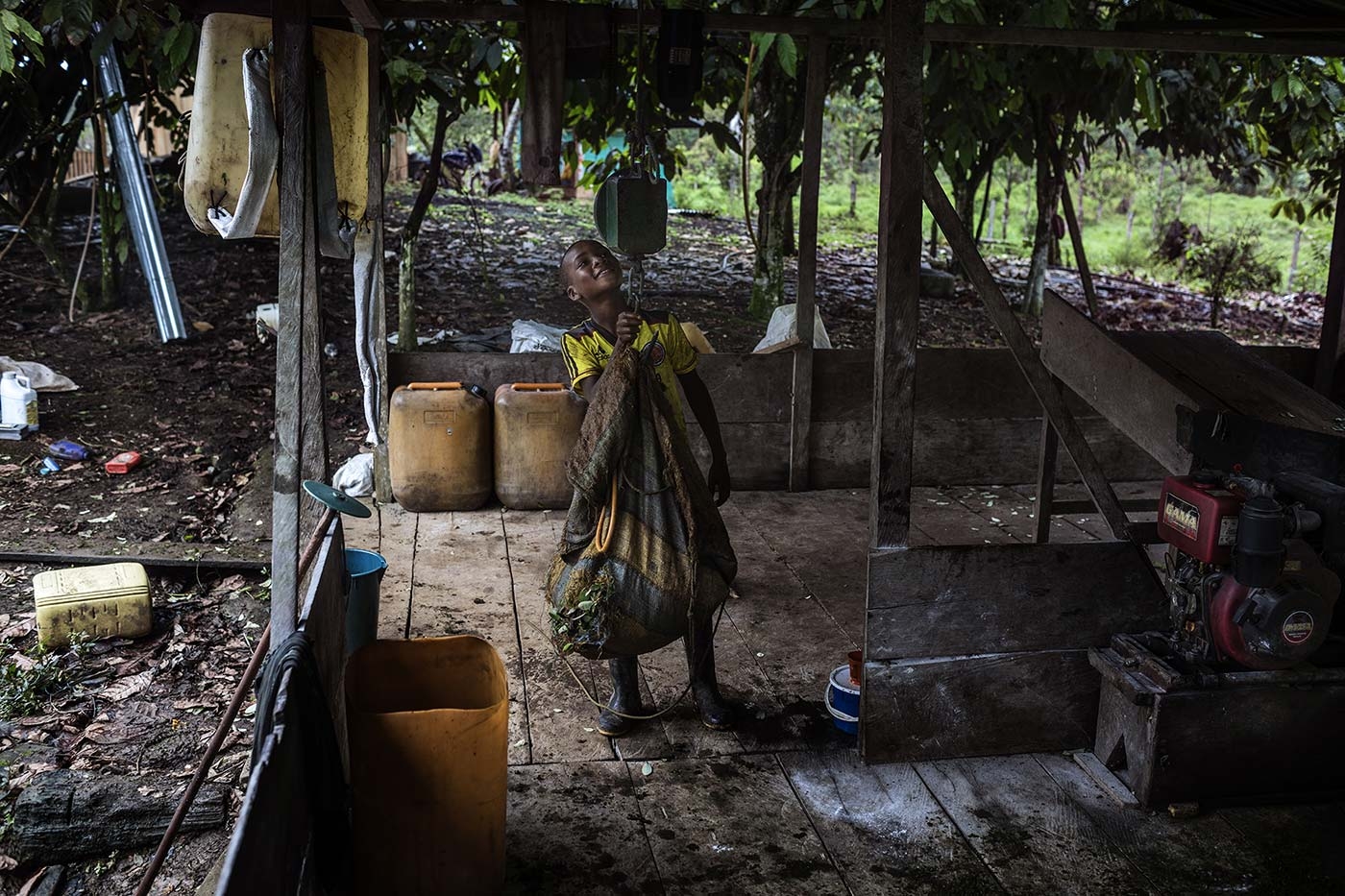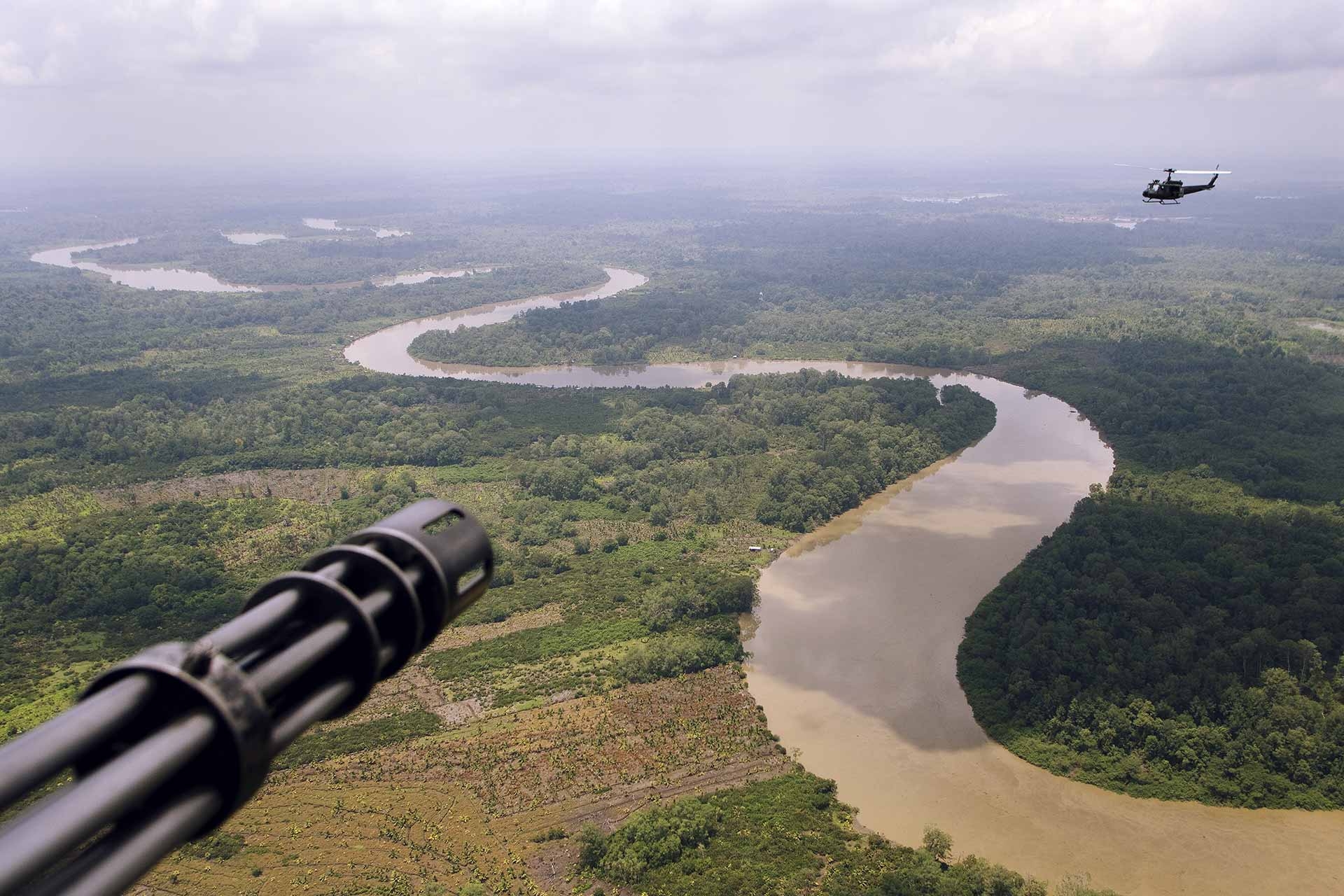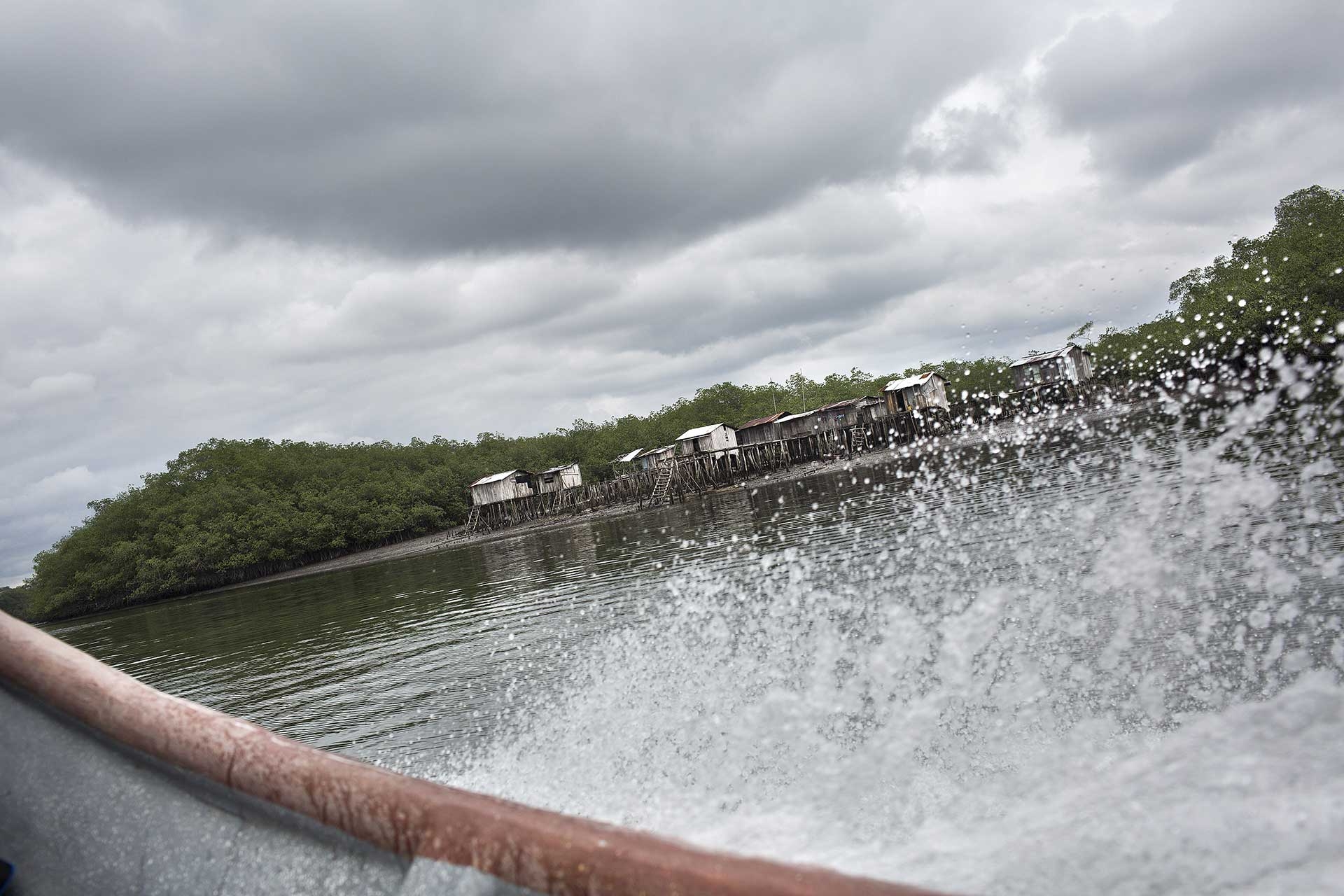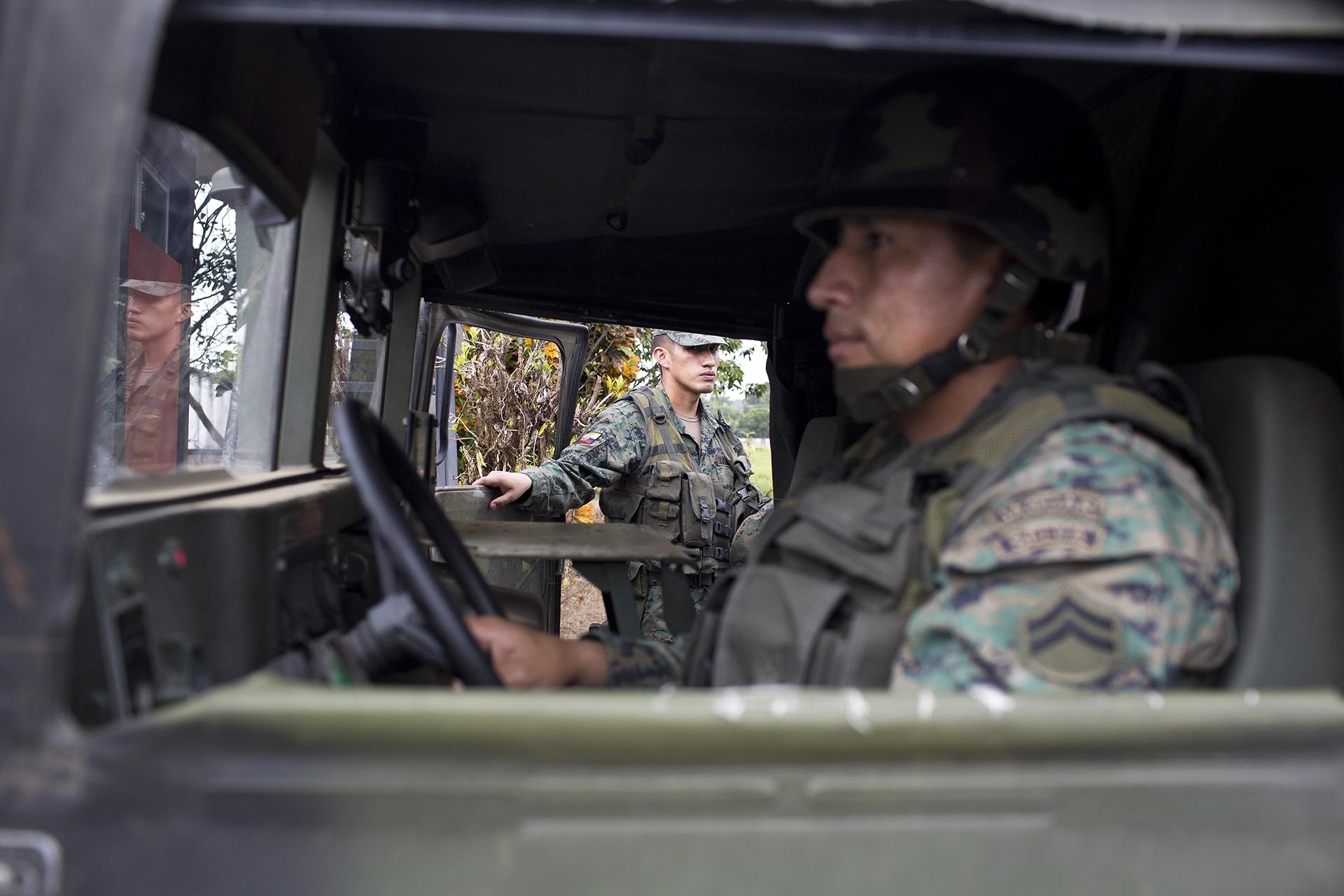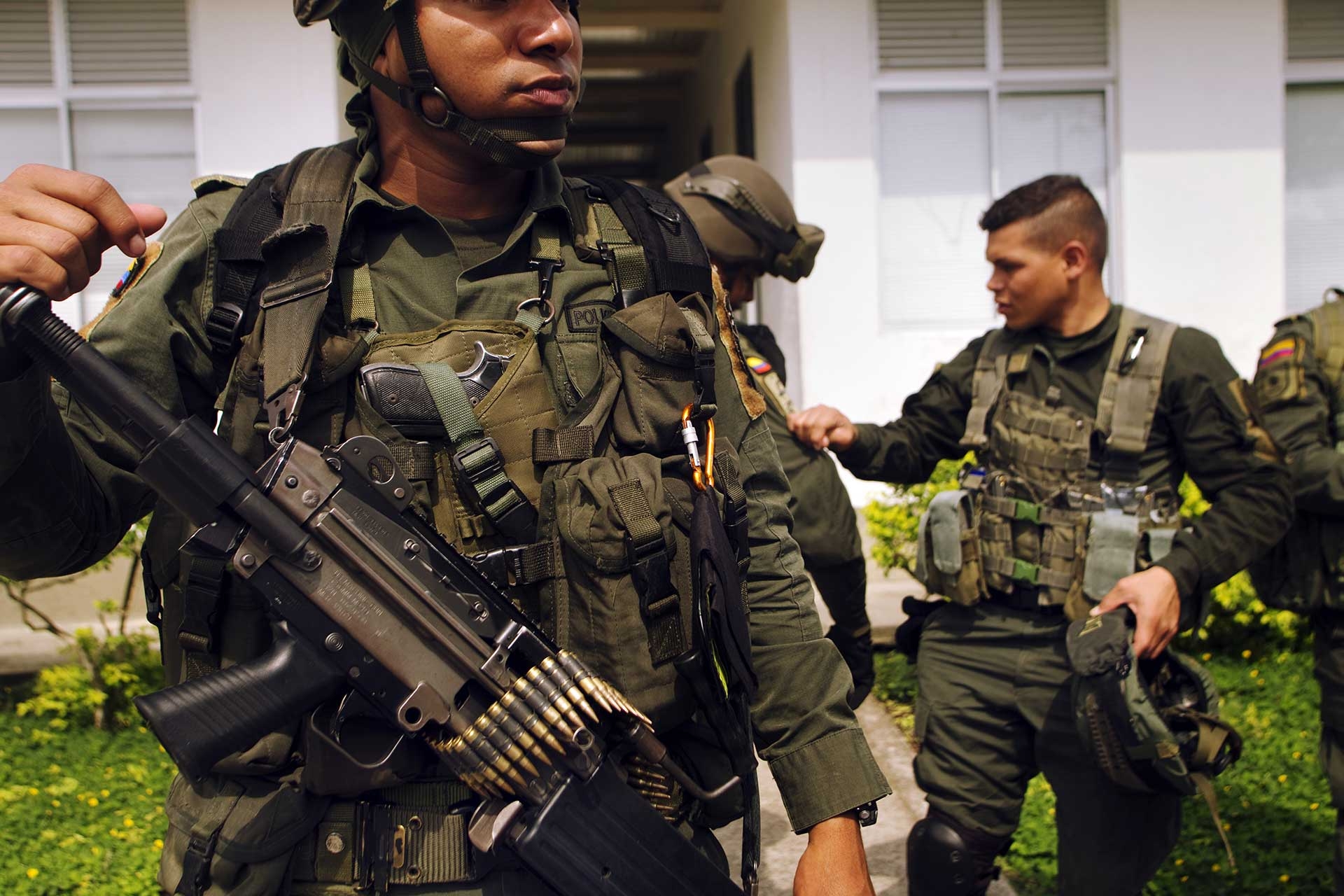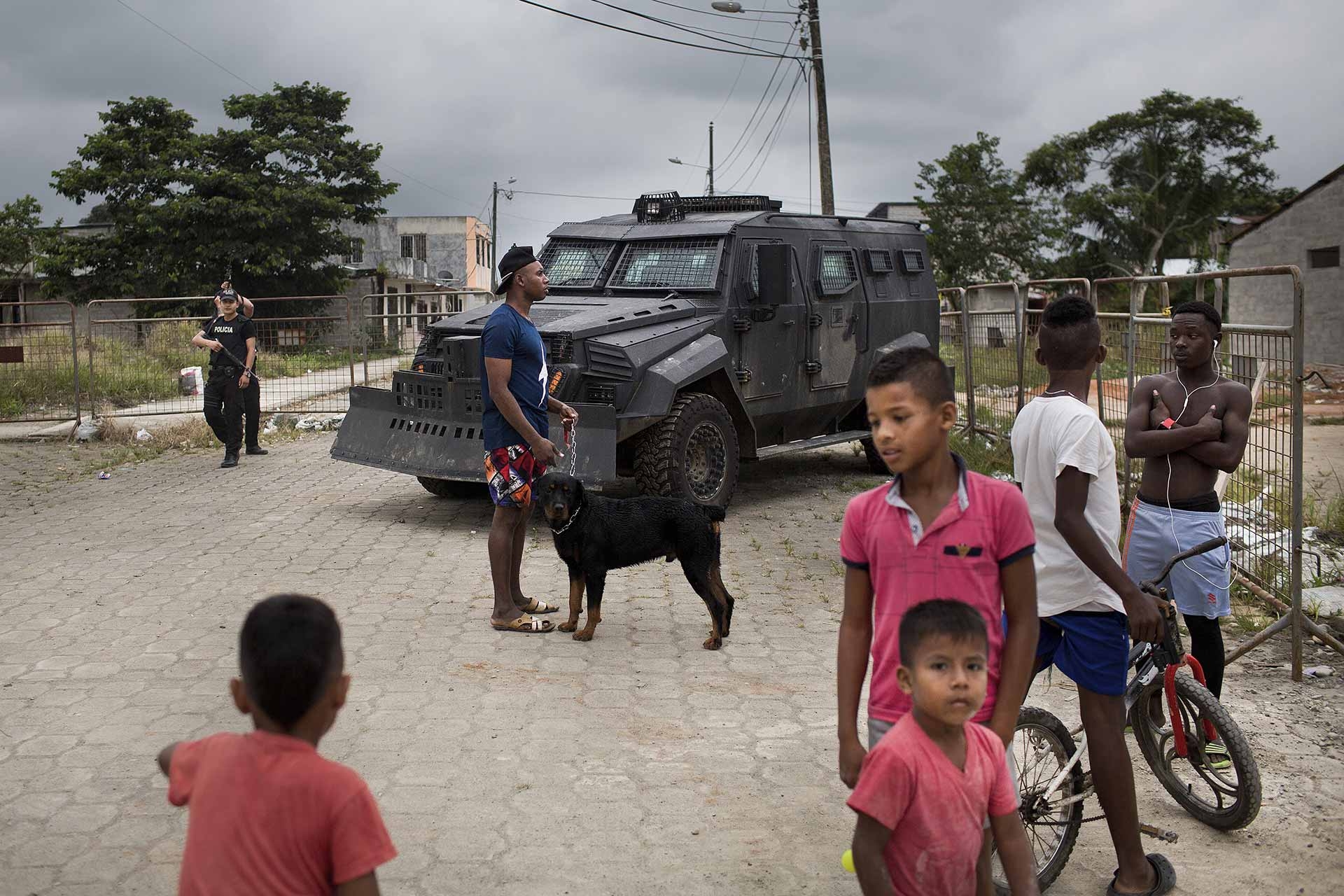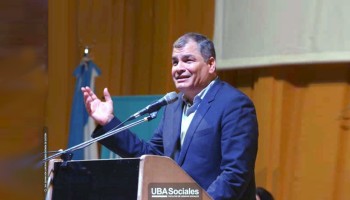The Mira Mataje River basin dividing Colombia and Ecuador is now home to the highest concentration of military troops along any border in Latin America. Some 13,000 Colombian and Ecuadorian soldiers are deployed there, tasked with battling eight different armed groups, who are fighting among themselves to control the drug trade.
The soldiers, policemen, special forces, pilots, and marines are not entirely welcomed by civilians.
“The army is harming us,” said a leader in Colombia’s Piguambí Palangala territory, home to the indigenous Awá people. He spoke on condition of anonymity out of fear of both the military and the drug traffickers.
Militarizing the rainforest hasn’t brought peace. Instead, the murder rate has skyrocketed, schooling and health care have been disrupted, and some families have been forced to flee their land.
Even finding out what’s happening has become exceedingly dangerous. Seven months ago, two journalists and a driver from El Comercio, an Ecuadorian newspaper, headed for the border to investigate an attack that had claimed the lives of four soldiers. The journalists were kidnapped by a Colombian drug gang and, despite protracted negotiations with the authorities, all three were murdered.
Driven by a need to document what exactly happened to their fallen colleagues, a group of more than 20 journalists from eight organizations have spent months delving into the tragedy (see: Tracing Their Last Journey).
The investigation, which is produced in part by the Organized Crime and Corruption Reporting Project (OCCRP), also looked into the broader picture of why this wild and beautiful place has become so perilous for locals and outsiders alike.
The Colombian and Ecuadorian response to local drug violence may be part of the answer.
“We have not seen any social investment, no development process, no institutional participation,” says Hugo Acero, a Colombian security specialist. “[Success] would require a comprehensive intervention, which would include the agricultural issue, health, education, roads. It’s difficult for it to work if the military focus is the only one.”
Cocaine Economy
Though the region is divided between the two nations, both sides of the border have much in common. The Esmeraldas province in Ecuador and Colombia’s province of Nariño are covered by thick rainforest that stretches from the shores of the Pacific Ocean all the way to the Andes mountains.
Afro-Americans make up a significant share of the population, and vast territories are home to the Awá indigenous nation. The majority of the region’s citizens, who live almost entirely in small villages, are classified as poor, according to government statistics.
The lack of economic opportunity is one reason why cocaine is king here.
Growing, refining, and trafficking the coca plant is a key source of income. An estimated 23,000 hectares of coca grow in and around Tumaco, the nearby Colombian port city and epicenter of the trade.
Dense jungle hides over a hundred laboratories. One such facility had the capacity to produce as much as two tons of cocaine a week. The drugs are transferred on river boats or in makeshift submarines secreted among the mangroves.
Over the last year, Tumaco has become a military hub.
In just 18 hours in the early days of 2018, over 2,000 soldiers arrived in the city’s small airport, spirited there aboard C-295 twin-turbo propelled planes, two Hercules C-130s, and a Boeing 727.
Colombia’s move to militarize the city came after eight coca-leaf farmers were slaughtered in a nearby rural area in October 2017.
Tumaco is now the center of a regional operation that involves over 8,300 soldiers and has a budget of US$ 598,600 for the year. An additional 1,300 police personnel are also taking part.
In their sights are many enemies, from ordinary criminal gangs to paramilitary groups, and even envoys from Mexican drug cartels.
But the main targets of the Colombian task force are drug gangs, some consisting of former members of the Revolutionary Armed Forces of Colombia (FARC) who went rogue after their leaders signed a peace deal with the Colombian government in 2016.
Among these is the Oliver Sinisterra Front: the band that claimed responsibility for kidnapping the Ecuadorian journalists. Said to be about 300 strong, it is led by a man the media in both countries calls “Public Enemy No. 1”: Walter Patricio Arizala Vernaza, popularly known as “El Guacho.” He is still on the loose.
A War Begins
In the words of Luis Carlos Villegas, then Colombia’s minister of defense, the mission of the Colombian operation was clear: to “regain the stability of the frontier.”
Within six months of their arrival, the troops conducted more than 100 missions along the border. In the first hundred days alone, they destroyed at least 72 drug labs and seized over 59 tons of cocaine. Perhaps their biggest victory was killing Victor David Segura, who headed a major drug trafficking group called the United Guerrillas of the Pacific.
Meanwhile, the Ecuadorian border task force seized an additional five tons of cocaine by mid-September and arrested over 1,000 people. It also confiscated weapons, fuel, chemicals, and almost 800 explosive devices.
But as the Colombian troops collaborated with Ecuadorian authorities, civilians on both sides of the border started to feel the rigors of war. In late January, a car bomb exploded in Ecuador for the first time in the country’s history. The attack, near a police station in the small town of San Lorenzo, was attributed to the Oliver Sinisterra Front and left 28 people wounded.
It also spurred Ecuadorian President Lenin Moreno to declare a regional state of emergency. The order limited civil liberties such as travel and the right to assemble and granted security forces the authority to enter people’s homes without a warrant.
And still the attacks continued. Two months later, the Oliver Sinisterra Front bombed power transmission towers, killed four Ecuadorian soldiers, and, in late March, kidnapped and later killed the El Comercio journalists. The size of the Ecuadorian task force reached 3,500 personnel in response to the events. Seventeen days after the journalists’ abductions, a press release attributed to the Oliver Sinisterra Front blamed the increased military presence for the journalists’ deaths.
In the first five months of the Colombian deployment, its security forces lost five men. The Oliver Sinisterra Front also shot and killed three Colombian detectives in July.
Trapped in the Crossfire
Increasingly, civilians are trapped in the crossfire between government forces and the criminal groups they’ve been sent to quash.
Military operations on both sides of the border have affected more than 34 Colombian communities of farmers, Afro-Colombians and peasants, according to a document from the country’s Ombudsman's Office, which is responsible for defending human rights. Since authorities stepped up action against the drug traffickers, that office and the local ombudsman for Tumaco have joined community leaders and peasant organizations in denouncing the militarization.
For many people in rural Ecuador and Colombia, the state played little if any role in their lives until the soldiers arrived.
About 85 percent of Tumaco’s population is classified as poor. The figure rises to 96 percent in rural areas. Just 5 percent of the city has sewer service; in 2011 infant mortality stood at 54 cases for every 1,000 births compared with a global average of 35.5 cases for the same period. Almost 70 percent of the city’s people are unemployed, and nearly half — more than 99,000 people — are registered as victims of conflict, a status that entitles them to financial compensation and priority access to schools, health care, and housing programs.
According to the Ideas Para la Paz foundation, a Colombian think tank that studies the country’s armed conflict, much of the violence is a result of the drug trafficking battle between the Oliver Sinisterra Front and another major group, the Guerrillas Unidas del Pacífico.
The war with the authorities is making everyday life even worse.
As the number of troops has swelled, so has the homicide rate. According to the Nariño provincial police, homicides jumped 34 percent to 332 between July 2017 and July 2018. In Tumaco, 147 murders were reported in the first half of this year, up 55 percent from a year earlier. And even Tumaco’s 2017 total was higher than that of the U.S. city of Las Vegas, which is 10 times its size.
Llorente, a medium-sized town near Tumaco about 15 kilometers from the border, is on the front line.
In the early 2000s, dozens of coca-growing families from other parts of the country relocated there after their crops were fumigated as part of the US-supported Plan Colombia program. Llorente is where many of the coca farmers get their fertilizers, tools, and materials. It has become a focal point for drug traffickers as well.
In the middle of the district, the indigenous Awá people of the Piguambí Palangala territory are doing their best to survive. One of its leaders, who spoke on condition of anonymity to protect his safety, said the number of troops traversing and staying on indigenous lands has jumped since June. That month, soldiers camped next to several schools. Classes were suspended due to worries about possible armed clashes.
It seems the soldiers are not always the best guests.
“I saw them taking fish from our ponds, taking hens to cook,” the Awá leader said. “They wait until the owner is gone, especially on Sundays, when people go to the market.”
The Awá also report being stopped by troops and accused of collaborating with drug traffickers.
“The security forces, they get you and say: ‘This one is a rebel,’ because we carry guns,” said one man, who did not want his name used for fear of retaliation. “But it is our indigenous tradition,” he explained. “We always carry our [caliber] 16, our ‘chimney,’ because we are from the mountains. We hunt.”
Another Awá, who also asked to remain anonymous, said soldiers labeled him a drug trafficker because of his clothes and rubber boots. He recalled soldiers accosting some of his companions and shouting: “Show us your hands! You have guerrilla faces. If you are with the guerrillas, we are going to light you up with bullets.”
According to Henry Marín of the Unipa, an indigenous organization that represents the Awá nation, nine other territories report similar conditions.
Drug traffickers have responded to the military presence by planting landmines and threatening indigenous authorities. Some, terrified of being murdered, have fled.
According to Anny Castillo, Tumaco’s ombudsperson, Afro-Colombian communities along the border face the same dangers. “Soldiers occupy houses and don’t want to give them back,” she said. “We also have information on thefts.”
A peasant association, Asominuma, also denounced alleged army abuses, including home occupations, raids and warrantless detentions.
In May, the national ombudsman asked the government to protect people and decried civil rights restrictions as well as arrests by the Ecuadorian army in Colombian territory.
Helping security forces is risky, said Juan Carlos Angulo of the Southern Pacific Community Councils, a group that represents Afro-Colombian communities.
“The soldiers arrive, they develop a relationship with the inhabitants, they talk with the children, they ask for water, and then they go away,” Angulo said. “When the illegal groups come back, they murder us. They push us out. They say that we are army collaborators.”
Jhon Aroca, commander of Colombia’s Special South Pacific Police Command, acknowledged that civilian relations are a challenge.
“We need to operate with a firm hand, but we know that we also need to be close (to the communities),” he said. “Most of them are not outlaws, but they are affected by the procedures. It is a very big challenge.”
Despite the heavy response, there are still many areas the authorities don’t control. Hugo Acero, the Colombian security expert, said the mission is tremendously difficult.
“The Colombian side is a jungle,” he says. “There are no roads … you can put in ten thousand soldiers and you won’t see any results. Secondly, the criminal organizations know the territory better — much better.”
Third, he said, Guacho and his group can camouflage themselves easily among the peasants.
The press officer representing General Jorge Hoyos, who commands all troops on the Colombian side of the border, did not respond to repeated interview requests and questions from reporters.
Different Country, Same Story
In Ecuador’s Esmeraldas Province, just across the Mataje river from Colombia, the social problems are very similar.
About 78 percent of the population has some aspect of its basic daily needs unmet: 64 percent don’t have drinkable water; 14 percent don’t have electricity; and in counties such as Eloy Alfaro, poverty is almost universal. As in Tumaco, 70 percent of the city of Esmeraldas’ population is unemployed.
And as in Colombia, homicides have surged. The region reported 66 murders in the first nine months of this year, up 32 percent compared with the same period in 2017. The rate is almost twice the national average.
Suffering manifests in smaller ways, too.
No one, not even doctors, can enter the villages without army escorts. Local officials can only get in with soldiers’ permission.
In February, Ecuadorian troops arrived in the Awá village of Guadualito and camped for more than two months. Roadblocks surrounded the town, preventing the indigenous population from going food shopping in San Lorenzo, a larger population center 45 minutes away. Residents had to stay put after 4 p.m. each day because soldiers said they couldn’t protect them at night, said Olindo Nastacuaz, a local leader.
“Without the authorization of the community, they used our schools, the communal house, the medical center and other places to stay,” he said. “It was an invasion.”
Forced to Abandon Their Homes
The conflict also devastated the small rural community of El Pan, near the Mataje River. When the war broke out in February, Ecuadorian army patrols were fired on by drug traffickers from across the river in Colombia.
A wave of fearful peasants took a few belongings and abandoned the village. Around 70 families, some carrying children and the elderly, walked for more than two hours to San Lorenzo, the region’s main city. They left behind their tools, animals, and appliances.
María Reinalda Tenorio can’t forget Feb. 17, the day a hail of bullets rained on her town. She was cooking when the machine guns started to pop, the first time she had ever witnessed a shootout in her 67 years. She ran outside and encountered soldiers who, without explanation, told her to leave.
“How do we get out?” she asked, “My husband can’t walk.” No response.
Together with her husband Jesús Caicedo, who has tuberculosis and can only walk very slowly and with assistance, Reinalda started the 30-kilometer trek to San Lorenzo.
According to one of Reinalda’s sons, Alveiro, he and three other people in El Pan were detained for hours.
“They arrested me, tied me up, and they kept me in the bushes,” he remembers. “They asked me who shot [at] them, but I didn’t now. They took out a knife and threatened to cut my legs to make me talk, but I didn’t know anything.”
The family is now settled in a half-finished house in San Lorenzo that shelters Reinalda, her husband, and eight of their 13 children, plus their daughters-in-law and 11 minor grandchildren.
Since their escape, the Tenorios have made several trips to El Pan, now a restricted zone, to search for their belongings. Very few were left. Scythes, machetes, and farm animals were nowhere to be found. Appliances and two gas cylinders that Reinalda had used to fry meat in her small restaurant were gone too.
“Life in El Pan was good,” María Reinalda recalls. “We had a peaceful life, nothing happened. We lived from our livestock, from our plantations. As a community, we protected the border, but now we [have become] refugees.”
Jesús, her husband, dreams of going back. He doesn’t like the noise of the city. He misses his land and the clean air. Now, if he wants to eat something, he has to buy it in a store. He is afraid to return to El Pan.
Alveiro, their son, works on an oil palm plantation earning $266 a month. “Now that I left, I lost everything,” he says. City services are virtually non-existent; when they arrived, San Lorenzo´s town hall gave them lunch, and that was all.
Back on the Colombian side of the border in Tumaco, local politicians and social leaders say they doubt the military intervention will bring peace. The enormous amount of money at stake is irresistible to too many, and the consequences of opposing the traffickers too violent.
The drug business has “structural roots in unemployment, poor education options, [and] lack of public services,” said Castillo, the Tumaco ombudsperson. “It is impossible to win the war without social investments,” she said. “You can arrest Guacho and the chiefs, but if Tumaco’s problems remain, new Guachos will rise.”
Father Arnulfo Mina, vicar general of the Diocese of Tumaco, agrees. Without better employment opportunities and education, he said, “we will keep burying people.”
